

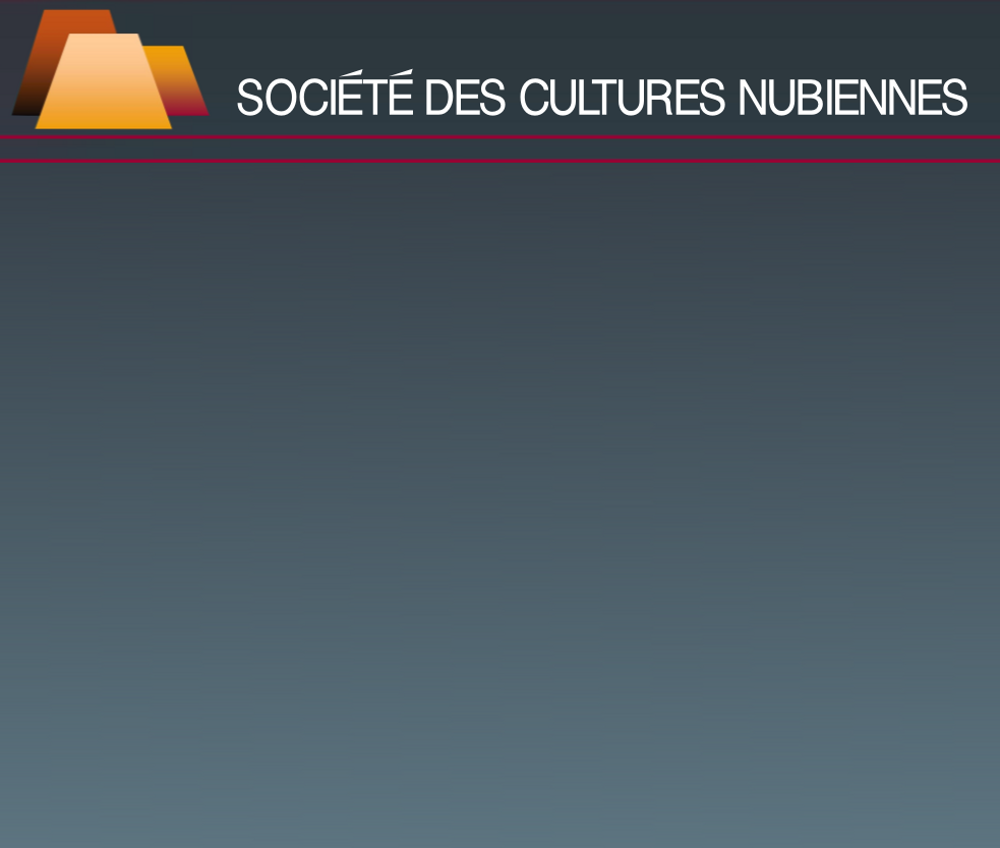
|
MEROE
The remains of the ancient capital of the kingdom of Meroe testify to its importance at the beginning of our era.
The political and cultural importance depended on: - its geographical position at the heart of the 'corridor of Africa' in a agricultural region between the White Nile and the Atbara, benefiting from good rainfall - its dominance over a part of the Red Sea - its mineral riches, including the gold mines.
Meroe is mentioned by the Greek and Roman authors: Herodotus, Strabo, Diodorus Siculus, Pliny, Heliodorus. A dignitary of the court of a 'queen of Ethiopia' (kandake), supervisor of all the treasures, is mentioned in the Acts of the Apostles. The conquest by Alexander the Great (331 BC) and, later, the Roman domination of Egypt influenced the political and commercial domains of the kingdom of Meroe. To these influences are added the geographical, geological and climatological factors that mark the local architecture. Thanks to the contacts maintained with Alexandria, foreign elements shape the character of Meroitic architecture. According to Friedrich Hinkel, the secular architecture centred on an urban habitat, while military installations and hafirs confirm the political and economic expansion to develop the hinterland. The remains of the capital also include religious and funerary elements, and it is above all the cemeteries that draw attention to themselves.
More than 400 pyramids, out of an estimated 1000, are still visible. Less high than the Egyptian pyramids, (ca 30m in height), they are spread over different locations: - The south cemetery is the oldest (VIII-IV Century BC) and includes some 200 graves of which some belong to the close relatives of the royal family that ruled Meroe on behalf of the kings residing at Napata. - The west necropolis with some 500 graves, of which about 100 pyramids were built for members of the royal family, confirming the wealth of the middle and upper classes. - The north cemetery, the most spectacular, with some 40 pyramids dating to between 225 BC and AD 15 was the golden period of the Meroitic kingdom. |
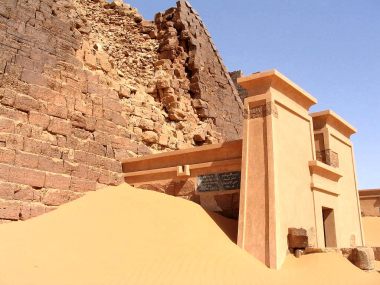 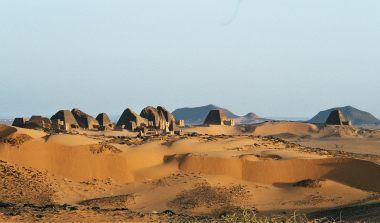 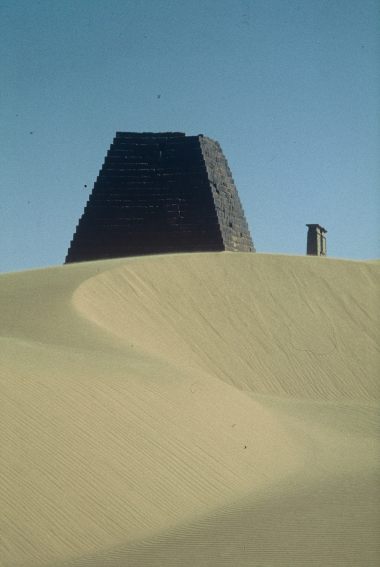 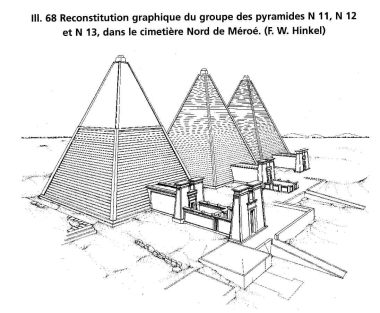 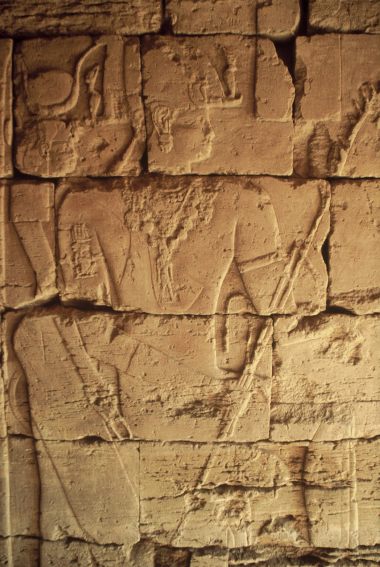 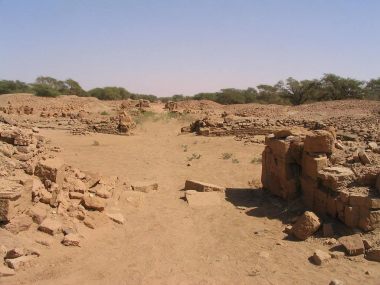 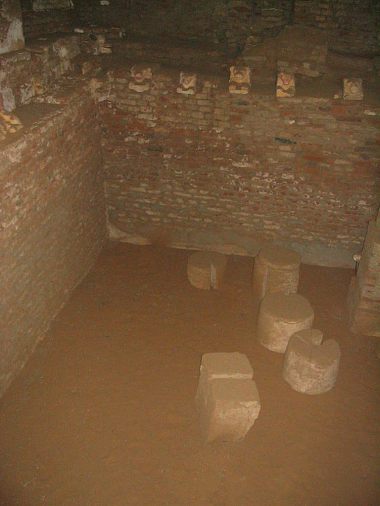 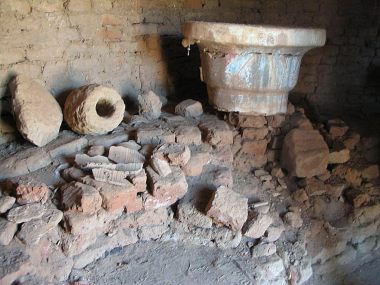 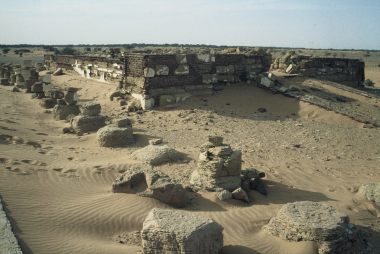 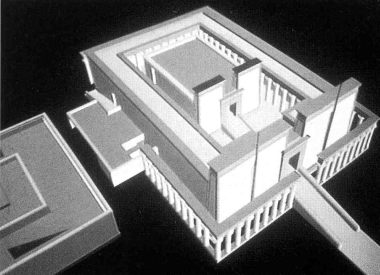 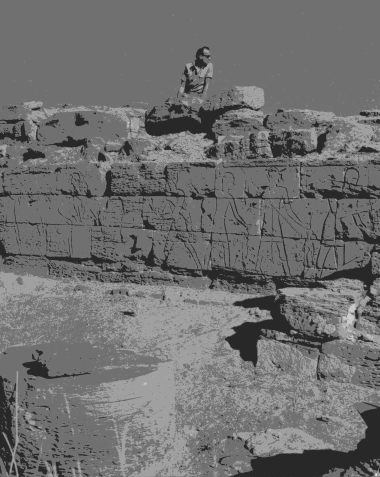 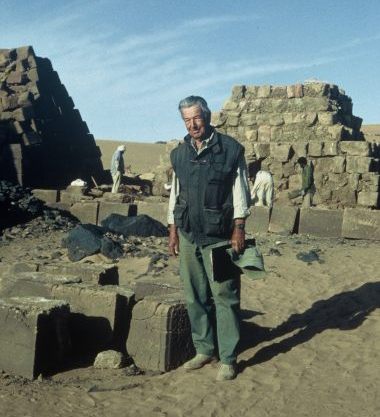 Pyramid's funeral chapel in the Meroe northern cemetery / Chapelle funéraire d'une pyramide de la nécropole nord de Méroé
From the southern cemetery, general view over the northern cemetery of Meroe / Depuis la nécropole sud, vue d'ensemble de la nécropole nord de Méroé
Natakamani's pyramid (12 before - 12 after Christ) in the cemetery of Meroe / Pyramide de Natakamani (aux alentours de notre ère) dans la nécropole nord de Méroé
Sudanese pyramid drawing by F. Hinkel. Singulary, its shape reminds a hieroglyphic sign that the Egyptians used in their writing (the determinative) / Dessin d'une pyramide soudanaise par F. Hinkel. Singulièrement, sa forme trés pointue rappelle un signe hiéroglyphique que les Egyptiens utilisaient dans leur écriture (le déterminatif)
In the funeral chapel, one bas-relief where the dead king received from his probable successor, the stick of millions of years / Dans la chapelle funéraire, bas-relief où le sucesseur probable du roi défunt, lui présente la tige de millions d'années
Central axis of the Amon's temple in the royal city of Meroe / Axe central du temple d'Amon dans la ville royale de Méroé
Natatio (swimming pool) of the royal therma of the city of Meroe / Natatio (piscine) des thermes de la ville royale de Méroé
Room linked to the natatio of the royal city thermae of Meroe / Salle annexe jouxtant le natatio des thermes de la ville royale de Méroé
Not far away from the royal city of Meroe, ruins of the sun temple where it's possible to see some periptere colonnade remains / Non loin de la ville royale de Méroé, vestiges du temple du soleil où on distingue les restes d'une colonnade périptère
F. Hinkel's model reconstituente the sun temple / Maquette de F. Hinkel reconstituant le temple du soleil
Personages on the base of the sun temple (photo Rex Keating) / Personnages représentés sur la base du temple du soleil (Photo Rex Keating)
The german architect and archaeologist, Friedrich Hinkel, has been in charge of Meroe during more than 45 years. He also saved during the Unesco campaign, the nubian temples situated on the Second cataract. Today, the temples are in the Khartoum Museum / L'architecte-archéologue allemand, Friedrich Hinkel, a été en charge de Méroé durant plus de 45 ans. Il a également sauvé les temples nubiens situés sur la Seconde cataracte durant la campagne de l'Unesco. Ces temples ont été réinstallés au musée de Khartoum.
|
| In 1976 Dr Friedrich Hinkel began the study and restoration of the cemeteries on the request of the National Corporation for Antiquities and Museums (NCAM). It was discovered that the superstructure has no pyramidion, but a simple platform at nine tenths of its height, most likely surmounted by a cylindrical or spherical stone with a solar disc. In front of the pyramid is a funerary chapel for the offering ceremony where the Egyptian deities, Osiris, Isis, Nephtys and Anubis appear. While alive the future occupant of the grave chose the location of his tomb, and had it excavated and decorated. After his death, his successor had the superstructure built (see drawing by F. Hinkel on the slide show)
The town extended over more than a square kilometre with suburbs to the north and the south. Today the remains of three temples may still be admired: - The temple of Amun (IV Century BC) is preceded by an avenue of rams built of stone, according to the classical plan of the Egyptian temple. - The temple of Apedemak, the god of war and fertility, whose structure included one or two rooms with decorated columns that recall the Hellenistic type. - The terraced temple called by Herodotus 'Table of the Sun' has an entrance pylon and a sanctuary room. The two colonnades that ran along each side of the temple wall are unusual. During the excavations, many human bones were found: the victorious kings may have executed the prisoners brought back to the capital.(see drawing by F. Hinkel on the slide show)
The royal city was surrounded by a wall and had numerous buildings, such as the astronomical observatory (identified through the reliefs found), an audience hall and baths that must have belonged to the palace complex. Meroe remains an impressive site, with its cemeteries and the details of its temples, built at a time when relations with the Greco-Roman world led to an exceptional development. |
|